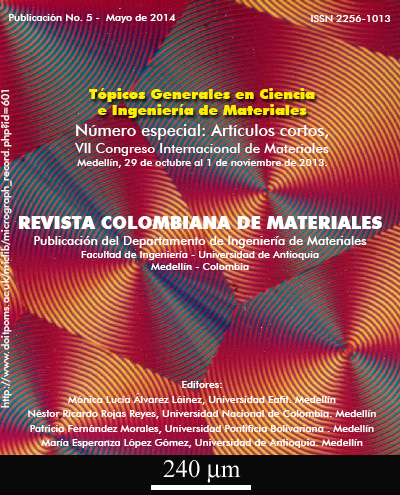EVALUACIÓN DE LAS PROPIEDADES MAGNÉTICAS Y DEGRADATIVAS EN AMBIENTE DE CLORUROS DE VIDRIOS METÁLICOS MAGNÉTICAMENTE BLANDOS
DOI:
https://doi.org/10.17533/udea.rcm.19424Palabras clave:
Vidrios metálicos, Materiales magnéticamente blandos, Resistencia a la corrosiónResumen
Descargas
Citas
H. Davies, Gibbs.M,“Soft magnetic materials Part 1. Amorphous alloys. Handbook of Magnetism and Advanced Magnetic Material”. Ed Wiley,Novel Materials, Vol. 4,pp. 1-21. 2003.
Inoue, A, Shena. B, Nishiyama.N,“Bulk Metallic Glasses: an overview”,Ed Springerlink,OakRidge USA, pp.2-25,2008.
Suzuki. K, Herzer. G,“Soft Magnetic Nanostructures and Applications”,Advanced Magnetic Nanostructures, pp. 365-401, DOI: 10.1007/0-387-23316-4_13. 2006. DOI: https://doi.org/10.1007/0-387-23316-4_13
Moscoso.O, Rosales.A,Pineda.A,“Propiedades térmicas y magnéticas de cintas magnéticamente blandas Fe80B10Si10 y Fe78B13Si9”,Revista Colombiana de Física, Vol. 39, No. 1,páginas.289.2007.
Park.J, Lakes, R. S,“Biomaterials. An introduction”. Springer, páginas.394,1992. DOI: https://doi.org/10.1007/978-1-4757-2156-0
Kim.J,Choi, Y.S, You, S.J,Shim. J,“Effect of Co on the corrosion resistance of 1% Cr-based steelsin a simulated underground environment”,Journal of Materials Science Letters,Vol. 22, pp. 619-621,2003. DOI: https://doi.org/10.1023/A:1023310815617
Nishimura.T, Katayama.H, Noda.K,Kodama. T,“Effect of Co and Ni on the corrosionbehavior of low alloy steels in wet/dryenvironments”,Corrosion Science, Vol. 42, pp.1611-1621.2000 DOI: https://doi.org/10.1016/S0010-938X(00)00018-4








